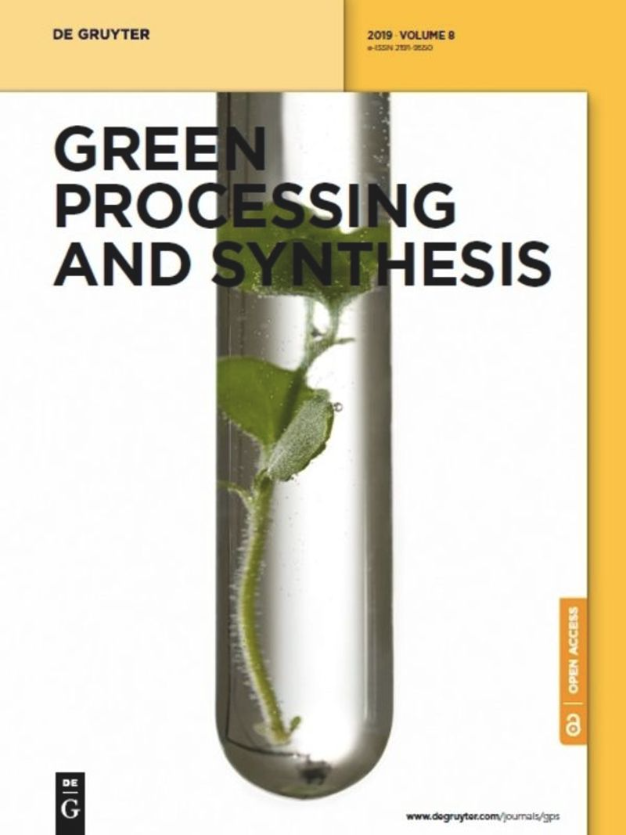Green synthesis of strontium-doped tin dioxide (SrSnO2) nanoparticles using the Mahonia bealei leaf extract and evaluation of their anticancer and antimicrobial activities
IF 3
4区 工程技术
Q2 CHEMISTRY, MULTIDISCIPLINARY
引用次数: 2
Abstract
Abstract In this study, a simple green method was employed to produce strontium (Sr)-doped-tin-dioxide (SnO2) nanoparticles (SrSnO2 NPs) using the Mahonia bealei leaf extract. The synthesized NPs were characterized with XRD, FE-SEM, FTIR, and PL spectroscopy measurements. SrSnO2 NPs were analysed for antimicrobial and anticancer activities. The XRD analysis revealed that the synthesized samples exhibited a tetragonal rutile crystal structure type of tin oxide. The EDX spectrum conforms to the chemical composition and elemental mapping of SrSnO2 NP synthesis. At 632 cm−1, the O–Sn–O band was observed and chemical bonding was confirmed using an FTIR spectrum. The PL spectrum identified surface defects and oxygen vacancies. The SrSnO2 NPs were tested against both Gram-positive and Gram-negative human pathogens. The synthesized nanoparticles exhibited effective antibacterial properties. The anticancer effects of SrSnO2 nanoparticles were also assessed against MCF-7 cells, and growth was decreased with increasing concentrations of the nanoparticles. Dual staining revealed high apoptosis in SrSnO2 NP-treated MCF-7 cells, proving its apoptotic potential. To conclude, we synthesized and characterized potential SrSnO2 nanoparticles using a green approach from the Mahonia bealei leaf extract. Further, green SrSnO2 nanoparticles showed significant antibacterial and anticancer properties against breast cancer cells (MCF-7) through apoptosis, which suggests a healthcare application for these nanoparticles. Graphical abstract An overview of the study presented in a schematic form.利用马洪叶提取物绿色合成锶掺杂二氧化锡(SrSnO2)纳米颗粒及其抗癌和抗菌活性评价
摘要本研究采用一种简单的绿色方法,以马洪叶提取物为原料制备锶掺杂二氧化锡纳米粒子(SrSnO2 NPs)。用XRD、FE-SEM、FTIR和PL光谱对合成的NPs进行了表征。分析SrSnO2 NPs的抗菌和抗癌活性。XRD分析表明,合成的样品呈现出一种四边形金红石型氧化锡晶体结构。EDX光谱符合SrSnO2 NP合成的化学组成和元素映射。在632 cm−1处,观察到O-Sn-O波段,并用FTIR光谱证实了化学键。PL光谱发现了表面缺陷和氧空位。SrSnO2 NPs对革兰氏阳性和革兰氏阴性人致病菌均进行了抑菌试验。合成的纳米颗粒具有有效的抗菌性能。SrSnO2纳米颗粒对MCF-7细胞的抗癌作用也被评估,随着纳米颗粒浓度的增加,MCF-7细胞的生长速度下降。双染色显示SrSnO2 np处理的MCF-7细胞凋亡高,证实了其凋亡潜力。综上所述,我们利用绿色方法从马洪叶提取物中合成并表征了潜在的SrSnO2纳米颗粒。此外,绿色SrSnO2纳米颗粒通过凋亡对乳腺癌细胞(MCF-7)表现出显著的抗菌和抗癌特性,这表明这些纳米颗粒在医疗保健方面具有应用价值。图形摘要以示意图的形式对研究进行概述。
本文章由计算机程序翻译,如有差异,请以英文原文为准。
求助全文
约1分钟内获得全文
求助全文
来源期刊

Green Processing and Synthesis
CHEMISTRY, MULTIDISCIPLINARY-ENGINEERING, CHEMICAL
CiteScore
6.70
自引率
9.30%
发文量
78
审稿时长
7 weeks
期刊介绍:
Green Processing and Synthesis is a bimonthly, peer-reviewed journal that provides up-to-date research both on fundamental as well as applied aspects of innovative green process development and chemical synthesis, giving an appropriate share to industrial views. The contributions are cutting edge, high-impact, authoritative, and provide both pros and cons of potential technologies. Green Processing and Synthesis provides a platform for scientists and engineers, especially chemists and chemical engineers, but is also open for interdisciplinary research from other areas such as physics, materials science, or catalysis.
 求助内容:
求助内容: 应助结果提醒方式:
应助结果提醒方式:


